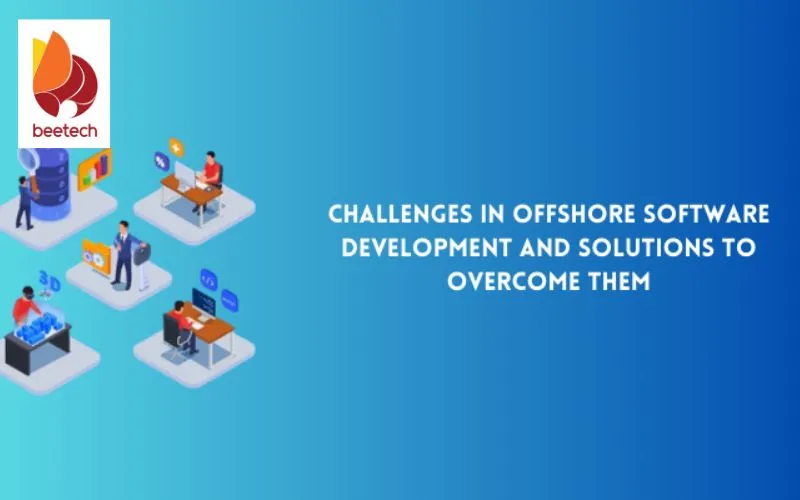Application software offshore development process
In today’s fast-paced digital world, businesses are increasingly turn to application software offshore development to streamline operations, reduce costs, and access global talent. This approach allows companies to collaborate with skilled development teams worldwide to create innovative, high-quality software solutions. Among the leaders in this space, BeetechSoft stands out as a trusted partner for businesses seeking seamless and efficient offshore development services. With expertise in managing every stage of the development process - from planning to deployment - BeetechSoft exemplifies the advantages of outsourcing software development to skilled offshore teams. This article provides an in-depth look at the application software offshore development process, highlighting key phases, challenges, and best practices to ensure success.

1. Understanding Application Software Offshore Development
Application software offshore development refers to the process of outsourcing the design, development, and maintenance of application software to teams located in different countries, typically where operational costs are lower and access to specialized talent is abundant. This model has gained immense popularity among businesses looking to create high-quality software solutions while optimizing costs and leveraging global expertise.
In offshore development, companies collaborate with skilled development teams across the globe to build various types of application software, such as mobile apps, enterprise software, web-based applications, and custom solutions. Offshore teams take on the responsibility of coding, testing, deploying, and even maintaining these applications, allowing businesses to focus on their core operations.
One of the main reasons businesses choose application software offshore development is the cost advantage. Countries with a thriving offshore development industry, like Vietnam, India, and Eastern Europe, offer competitive labour rates while maintaining high standards of quality. This enables businesses to reduce expenses without compromising the functionality or performance of their application software.
Another key advantage is access to a global talent pool. Offshore development opens up opportunities to work with highly skilled developers and specialists who are proficient in the latest programming languages, frameworks, and tools. This means businesses can take advantage of emerging technologies such as artificial intelligence, blockchain, and cloud computing without investing heavily in in-house resources.
Furthermore, application software offshore development provides flexibility and scalability. Companies can adjust the size of their offshore teams based on project needs, ensuring efficient resource allocation throughout the development cycle. By understanding the benefits and process of offshore development, businesses can create powerful, innovative applications that meet their strategic goals while remaining cost-effective.
>>> Read more: Top 5 software outsourcing in vietnam
2. Key Phases of the Offshore Development Process
The application software offshore development process involves several key phases designed to ensure seamless collaboration, efficient workflows, and the successful delivery of high-quality software. Understanding these phases is crucial for businesses seeking to maximize the benefits of offshore development while minimizing risks. Below is a detailed look at the essential stages of this process:
2.1. Planning and Requirement Gathering
The first phase of application software offshore development involves clearly defining project goals, requirements, and deliverables. This step ensures alignment between the client and the offshore team. Businesses work closely with offshore developers to outline the scope of the project, prioritize features, and set timelines. Effective communication at this stage is vital to establish a shared understanding of expectations and avoid future misunderstandings.

2.2. Team Selection and Onboarding
Choosing the right offshore development team is critical to the success of the project. During this phase, businesses evaluate potential offshore partners based on their expertise, technical skills, and experience in delivering similar projects. Once selected, the onboarding process involves introducing the offshore team to the project, sharing key documentation, and setting up collaboration tools for seamless communication.
2.3. Design and Prototyping
In this phase, the focus shifts to creating the design and architecture of the application software. The offshore development team works on wireframes, prototypes, and user interface designs to ensure the application meets the client’s vision and usability standards. Regular feedback loops with the client help refine the design and align it with business objectives.
2.4. Development and Implementation
The development phase is where the core coding of the application takes place. Offshore teams follow agile or waterfall methodologies, depending on the project's complexity and requirements. Developers focus on building the application’s features, integrating functionalities, and ensuring compatibility with the intended platforms. Regular progress updates and sprint reviews keep the client informed about the development’s status.
2.5. Testing and Quality Assurance (QA)
Once the application is developed, rigorous testing and quality assurance processes are conducted to identify and fix bugs, ensure functionality, and optimize performance. Offshore QA teams perform various types of testing, such as unit testing, integration testing, and user acceptance testing (UAT). This phase ensures that the software is stable, secure, and ready for deployment.
2.6. Deployment and Launch
After successful testing, the application is deployed to the production environment. Offshore teams assist in setting up the necessary infrastructure, ensuring a smooth and error-free launch. During this phase, businesses and offshore developers work together to monitor the initial performance of the application and address any post-deployment issues promptly.
>>> Read more: What is the common point of it services outsourcing companies Vietnam
2.7. Ongoing Support and Maintenance
The final phase of application software offshore development involves providing continuous support and maintenance. Offshore teams handle updates, monitor performance, fix any emerging bugs, and implement enhancements as needed. This ensures the application remains up-to-date, secure, and aligned with evolving business requirements.

By following these key phases, businesses can streamline their application software offshore development process, ensuring effective collaboration with offshore teams and the successful delivery of software solutions that meet their goals and exceed expectations.
3. Challenges in Offshore Development and How to Overcome Them
While application software offshore development offers cost savings and access to global talent, it comes with challenges that businesses must navigate for a smooth development process. Here are the key challenges and solutions:
3.1. Communication Barriers
Language, culture, and time zone differences can lead to misunderstandings and project delays.
Solution:
Collaboration tools like Slack and Zoom can be used to communicate clearly..
Set fixed meeting schedules accommodating time zones.
Provide detailed documentation and visual references.
3.2. Time Zone Differences
Different work hours can slow decision-making in application software offshore development.
Solution:
Implement overlapping work hours for critical discussions.
Use project management tools like Jira or Trello for real-time tracking.
3.3. Quality Assurance and Control
Ensuring high-quality standards in application software offshore development can be difficult with remote teams.
Solution:
Adopt agile development with iterative testing.
Conduct regular code reviews and automated testing.
3.4. Security and Data Privacy Risks
Offshore teams handling sensitive data pose risks of breaches and IP theft.
Solution:
Partner with firms following ISO 27001 and GDPR compliance.
Sign NDAs and enforce strict access controls.
3.5. Cultural and Work Ethic Differences
Varied work styles in application software offshore development may lead to inefficiencies.
Solution:
Conduct cultural training and encourage open feedback.
Align expectations through clear project guidelines.
3.6. Project Management and Coordination
Managing offshore teams effectively is key to successful application software offshore development.
Solution:
Assign a dedicated project manager.
Use centralized tracking tools for monitoring progress.
3.7. Scalability and Resource Allocation
Scaling application software offshore development teams can be complex without proper planning.
Solution:
Partner with offshore firms offering flexible engagement models.
Regularly assess resource needs and adjust accordingly.
By proactively addressing these challenges, businesses can maximize the benefits of application software offshore development, ensuring efficiency, quality, and security. Selecting the right offshore development partner is crucial for long-term success.
Conclusion
The application software offshore development process offers businesses an effective way to innovate, reduce costs, and deliver high-quality applications. By partnering with experienced providers like BeetechSoft, companies can ensure smooth collaboration, robust solutions, and timely project delivery. From planning and design to deployment and ongoing support, BeetechSoft’s expertise ensures that every stage of the development process aligns with your business goals. As businesses continue to seek scalable and efficient software solutions, offshore development remains a game-changer in driving growth and competitiveness. Explore the potential of application software offshore development with trusted partners like BeetechSoft to unlock the benefits of global collaboration.
